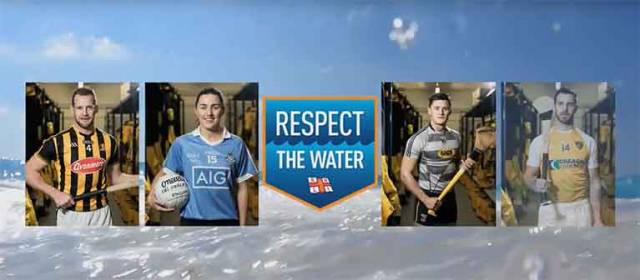The Royal National Lifeboat Institute (RNLI) and the GAA have announced a major partnership aimed at reducing the number of people who lose their lives though drowning in Ireland. Each year an average of 28 people drown accidentally around the Irish coast.* The RNLI aims to halve coastal drowning by 2024 and the GAA will work with the charity to engage with clubs and communities, particularly on the coast, to provide information and support that could save lives.
The RNLI’s drowning prevention campaign ‘Respect the Water’, will be supported through the GAA’s Healthy Clubs initiative and the wider club network. Many GAA clubs are based in coastal communities with 333 of them in a 10km radius of the 46 RNLI lifeboat stations in Ireland. Their location makes them ideally placed for sharing information and raising awareness of the causes of drowning and how to prevent it.
In announcing the partnership, the President of the GAA, Aogán Ó Fearghaíl says, ‘In the RNLI the GAA sees an organisation that mirrors its core values of community activity and volunteerism. We welcome the 'Respect the Water' campaign and its efforts to keep people safe all year round.’
Joining the President at the launch is RNLI Chief Executive, Paul Boissier, who added, ‘Drowning devastates communities, but it’s often accepted as just part of life by the water. We believe that many of these deaths are preventable and we need to work with other organisations who, like us, want to keep their communities safe. Much like a lifeboat station, a GAA club is at the heart of community life. Sporting communities can play a major role in preventing deaths by drowning. Through their approach to the sport and their position in the community they are well placed to be lifesavers.’
Through the partnership the RNLI invited the GAA to their training college in Poole and to Portsmouth University, to meet cold water shock expert Professor Mike Tipton. Four GAA athletes; Jackie Tyrell from Kilkenny, Lyndsey Davey from Dublin, Neil McManus from Antrim and Lee Chin from Wexford experienced what it was like to be plunged into cold water and see the effects of it on the body. The athletes, along with representatives of four coastal ‘GAA Healthy Clubs’ (Bray Emmets, Wicklow; St. Peter’s, Down; Achill, Mayo, and Castlehaven, Cork), also took part in rescue scenarios in specially created challenging weather and sea conditions.
Dublin footballer and three times GAA All-Star, Lyndsey Davey, has a very personal reason for getting involved in the campaign. Her great uncle Michael Hayes was the skipper on the Tit Bonhomme, which sank off Glandore Harbour with the loss of five of the six crew, including Michael. Lyndsey says, ‘The loss of Michael and his crew was a very difficult time for all the families involved. During the days and weeks following the sinking, the whole community of Union Hall really came together. The search and rescue efforts were relentless and the support given was incredible. I got involved in this campaign as I wanted to give something back and help create awareness around water safety and drowning. In doing so I hope we can prevent any family the pain of losing a loved one through drowning.’
All-Ireland winning Kilkenny hurler Jackie Tyrrell said, ‘Like many people in Ireland I too have lost someone close to me to drowning. So many of our clubs live and train near the water, whether on the coast on near inland rivers and lakes. We have a responsibility to help and our sport and our ethos encourage this. I know our supporters get behind us in our games, now we are asking them to get behind this campaign; it could help save a life.’
Antrim Champion Hurler and Cushendall native, Neil McManus, has been at the fore in driving the partnership and added, ‘The stories of loss through drowning that we’ve heard from the RNLI really hit home. You can’t help but think of the grief of the families. I play hurling across the road from the local lifeboat station and I know not everyone can be rescued. In backing this campaign I hope that the message reaches as many people as possible because no family should have to suffer the pain of losing a loved one through drowning.’
Wexford Hurler Lee Chin has also put his full support behind the campaign. Lee says, ‘Visiting the RNLI College and taking part in the exercises and rescue scenarios has made me aware how quickly people can get into trouble in the water. Simple advice and information can save lives and reduce the numbers of people drowning in Ireland.’
The athletes and Healthy Clubs representatives were joined at the launch by Kerry footballer Killian Young and Cork footballer Brian Hurley. Both athletes live near the RNLI lifeboat stations, Union Hall and Valentia and are backing the Respect the Water campaign.
Legendary broadcaster Mícheál Ó Muircheartaigh, who was Master of Ceremonies for the launch, has also narrated a specially commissioned short film for the partnership, which was given its first screening at the event.
The RNLI will work with the GAA and their volunteers in local communities to promote the campaign and share key safety messages and advice.






























































